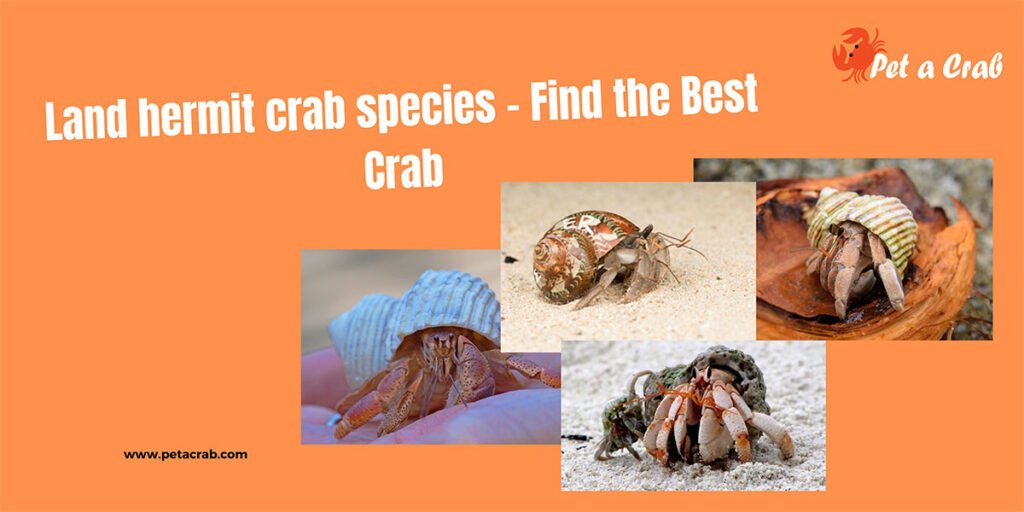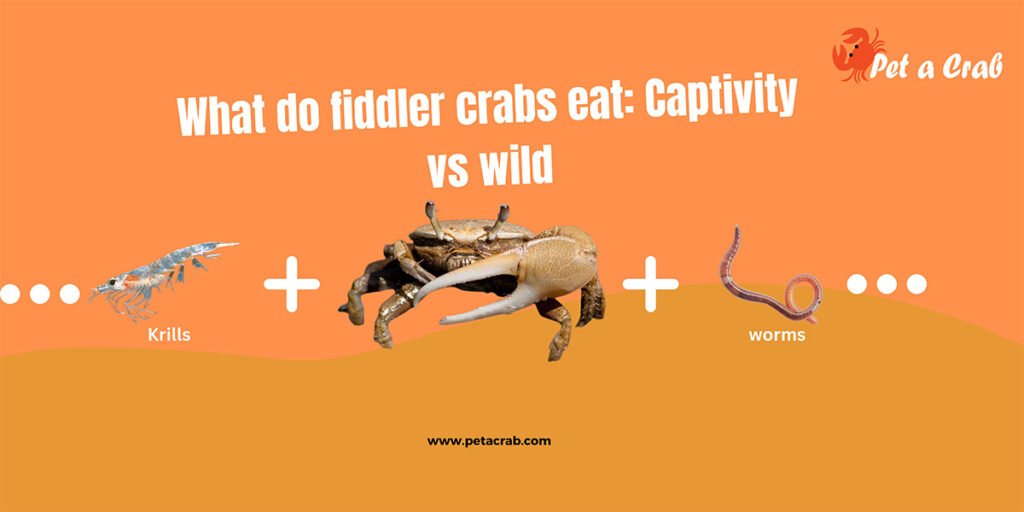Thin striped hermit crab, a hardy cleaner in your saltwater aquarium. These little pets, with their striking looks and tireless cleaning habits, can bring life and personality to any tank. It’s been a long time since I’m writing about any hermit crab; I hope you will find it informative.

If you are curious about their facts and behavior or looking for care advice to keep them thriving, I covered everything you need to know about this crab; let’s jump into the topic.
Quick overview of thin striped hermit crab
- Common names: Thinstripe/Thin striped hermit crab,
- Scientific name: Clibanarius vittatus
- Care level: Easy
- Temperature: 72-78°F (22-26°C)
- Temperament: Peaceful/Semi-aggressive
- Color: Greenish Gray
- Size: 3-5 inches
- Diet: Omnivoer
- Reef safe: Yes/Caution
- Habitat type: Saltwater aquarium
- Sleeping nature: Nocturnal
Note: I didn’t find any clue about their lifespan; depending on some other marine hermit crabs, the lifespan could be around 3 years.
Thin striped hermit crab habitat
Thin striped hermit crabs love the warmer parts of the Atlantic Ocean, where they scavenge for food both on land and underwater. You can find them from Virginia to Brazil, especially along Florida’s coast, living in various coastal areas. Whether it’s sandy beaches, rock jetties, seagrass beds, or mangroves, they adapt well to their surroundings, even handling salty or brackish water with ease.
In the Caribbean, Gulf of Mexico, and western Atlantic, these crabs thrive in shallow waters, often hanging out in exposed areas during low tide. They can be found in depths up to 22 meters, especially in sheltered environments like mudflats or mangroves. One of their favorite spots is the Indian River Lagoon, where they’re commonly seen in many different habitats. This adaptability helps them become one of the most common hermit crabs in those regions.
Are thin striped hermit crabs fully aquatic?
Thin striped hermit crabs (Clibanarius vittatus) are fully aquatic creatures. Although they may sometimes be spotted scavenging above the waterline in their natural habitat, they need to stay submerged for their health. These crabs are marine hermits, meaning they thrive in underwater environments and use gills to breathe. Spending too much time out of the water can cause serious harm, so it’s important to treat them like other marine crabs by ensuring they remain in water at all times in your tank.
In the wild, thin striped hermits can handle short periods out of the water, but they are not built to stay on land for long.

Appearance
Thin striped hermit crabs, known for their striking appearance, have a unique look that stands out. Their legs are pristine white, which creates a sharp contrast against their reddish-brown or bluish-black exoskeleton. This contrast makes them one of the more visually appealing hermit crabs to spot, especially in their natural environment.
Their body color is usually a mix of greenish to gray, with beige or white striping that runs down their legs. What’s really fascinating is their claws. They are equal in size and feature blue bumps, opening to reveal tiny teeth. These details make thinstripe hermit crabs quite distinctive.
Another feature that makes them special is their curved abdomen, which helps them comfortably fit into shells. On top of that, they have long eye stalks that protrude, giving them a quirky, almost cartoonish look, along with their stalked eyes and claws for feeding.
Are thin striped hermit crab reef safe?
Thin striped hermit crabs are generally reef-safe and won’t eat corals; however, most aquariums suggest being cautious with them.
How big do thin striped hermit crabs get?
Thin striped hermit crabs (Clibanarius vittatus) can grow to an impressive size for hermits. Most of the ones I’ve seen reach around 6 to 10 cm (2.5 to 4 inches) in length, which means they can comfortably inhabit shells that are about 4 inches long. In terms of carapace size, they typically measure between 14 to 17 mm. For comparison, they start off around 3 inches or 75mm, but can max out at 5 inches as adults.
One important thing to note is that as they grow, they gain enough strength to topple over loose rockwork or decorations.
Beahavior
Thinstripe hermit crabs are incredible tank cleaners. They tirelessly work to keep your tank pristine by foraging for algae, detritus, and uneaten food, making them ideal for maintaining water quality. Renowned for their excellent algae-eating skills, they help control unwanted algae growth, including hair algae, film algae, and even some types of turf algae. Their fast-moving, hardy nature makes them a perfect addition to any tank, especially for beginners and experienced aquarists alike.

These peaceful crabs thrive in community tanks, coexisting well with other marine life. One of their unique behaviors is how they handle outgrowing their shells. They get together with other crabs to tap on each other’s shells when they need a new home. When two crabs like each other’s shells, they swap them, which is an interesting method of finding new shells.
In the wild, thin striped hermits often carry sea anemones on their shells for mutual protection called sybiotic relationships; the anemone gets free riding and srap of food and the crab gets protection, which is another cool thing about them.
Thinstripe hermit crabs adapt well to a variety of conditions. They can handle dry conditions better than most, often spotted on exposed tidal flats, but they’re also fully equipped to thrive underwater thanks to their gills.
How to care for thin striped hermit crab
Tank setup
Size
They need plenty of space to forage, so consider a minimum 10 gallon tank for this crab. If you are planning a full reef tank, you should go for a 25-30 gallon tank.
Substrate
Choose sand as the main part of the substrate with some gravel so that the crabs can burrow; don’t use big stones to prevent them from getting stuck.

Decoration
Give plenty of space with rocks, live rocks, corals, caves and anything you like. Use other equipment, like a filter and thermometer. Light should mimic natural sunlight or 12 hours of light and 12 hours of dark. Consider keeping some climbing medium, like Caulerpa plants, which will give them more space to play around.
Water parameters
When setting up a tank for thin striped hermit crabs, aim for a temperature of 72-78°F (22-26°C), with a pH level between 8.1-8.4 and specific gravity around 1.023-1.025. They’re pretty hardy, so as long as you cycle the tank properly, they’ll adapt well. Adding live rock can help with filtration, mimicking a more natural environment for them. Cycling the tank ensures stability, which is key for their long-term health.
Note: If you can keep some land area in the tank, that would be the best mimic of their natural habitat.
What do thin striped hermit crabs eat?
When it comes to feeding thin striped hermit crabs, their diet is a mix of algae, detritus, and whatever they can scavenge. In the wild, these crabs mainly eat detritus found in the substrate, along with small plants and dead animals. They also use their claws to break open small mollusks when the opportunity presents itself. In your tank, they’ll eagerly seek out leftover food, detritus, and various algae like hair algae and film algae.
To ensure they stay healthy, I always suggest supplementing their diet with seaweed, algae wafers, or small meaty foods like pellets, chopped shrimp, bloodworms, or frozen marine foods.
These crabs are relentless scavengers, always on the hunt for something to eat. They consume a variety of things, from around 40% scavenged material, 40% detritus, and about 20% substrate. If you want to keep them happy in a tank, providing a balanced mix of food like algae, small fish food, and some occasional treats will keep them thriving. Just make sure they always have enough to forage, as their scavenging instincts are strong.
Tank mates
Thin striped hermit crabs (Clibanarius vittatus) are generally peaceful and make good tank mates for many fish and invertebrates. I’ve found that they tend to get along well with larger, calm species like tangs and rabbitfish. However, be cautious with smaller fish that burrow near the substrate, as these crabs may disturb them while scavenging. They are great for mixed tanks as long as their environment is stable.
That being said, hermit crabs can be opportunistic, and thin striped ones are no exception. They may attack snails or even other hermits to claim a better shell, so you’ll want to keep an eye out for this behavior, especially if shells are in short supply. Providing extra empty shells of various sizes can help reduce conflicts and give them options.
One thing I’ve noticed is that their larger size compared to other hermits means they can easily knock over loose objects in the tank. Be sure to secure decorations and corals to avoid disruptions. When given enough space, they’re fascinating additions that bring a lot of personality to a marine setup without causing too much trouble!
About shells of thin striped hermit crab
When keeping thin striped hermit crabs (Clibanarius vittatus), shells play a crucial role in their care. As they grow, they need new shells to accommodate their size. In the wild, they use various shells like whelks and conchs, with species like Stramonita haemastoma, Cymatium parthenopeum, and Achatina fulica making up over 98% of their shell choices. I’ve noticed that males and intersex crabs tend to use larger shells, while females usually go for smaller ones. Shell choice is really important, and without enough options, crabs may fight or even kill mollusks to secure a shell.
To prevent aggression, it’s best to offer five or six different sized empty shells for each crab. This way, they can find the perfect fit as they grow. If they’re stuck without a new shell, their vulnerability increases, especially to predators. In my experience, having extra shells available keeps things peaceful in the tank, since hermit crabs don’t naturally socialize much but will compete fiercely for shells. You’ll want to include shells that vary in both size and shape to meet their changing needs.
One interesting thing I’ve noticed is how large their shells can get—some crabs even use a 5-inch horse conch shell! So be prepared to supply larger shells over time as they grow.
Reproduction
When it comes to reproduction, thin striped hermit crabs have a fascinating process. Males start by tapping on the female’s shell to initiate mating. After fertilization, females carry their eggs on their abdomen in a mass called a “sponge,” which can hold anywhere from 1,000 to 30,000 eggs at a time. In warmer waters, females can produce up to 180,000 eggs annually. The development speed of these eggs depends a lot on temperature, with eggs hatching in about 60 days at 77°F, but they won’t develop at all in temperatures as low as 59°F.
Once the eggs hatch, the larvae are released into the water and go through several stages of development. These stages take anywhere from 24 to 91 days, depending on the environment, before they settle on the ocean floor and transform into juvenile crabs. Warmer months are typically when you’ll see more reproductive activity since warmer water speeds up the whole process.
Maintaining the right water temperature is key to their successful reproduction in captivity, though there is no record of successful reproduction in captivity. Warmer, stable conditions will help ensure the healthy development of the eggs, and keeping the water parameters stable will encourage natural behavior.
Recommendation: Learn about strawberry crabs


